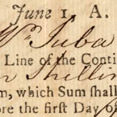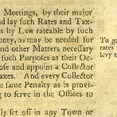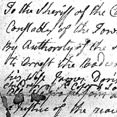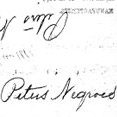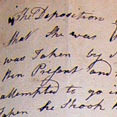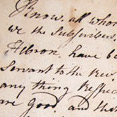Freedom: Documents & Activities
Gladstone Collection, Manuscript Division, Library of Congress
http://memory.loc.gov/ammem/index.html
In 1777 Juba, a Milford, Connecticut, slave, enlisted in a segregated regiment of the Colony of Connecticut. One-half of Juba’s pay went to his master, perhaps to purchase his freedom.
Yale Collection of American Literature, Beinecke Rare Book and Manuscript Library, Yale University
While the State of Connecticut introduced an act of gradual emancipation in 1784, the lives of Connecticut’s slaves remained regulated by the state
Elijah Graves Complaint
Hebron, CT; September 27, 1787
Courtesy, Hebron Historical Society, Hebron, CT
After Cesar and Lowis Peters and their children had been seized and carried away, Elijah Graves, a local tailor, swore out a complaint against Cesar and his wife and children, claiming they “are all guilty of theft” of various articles of clothing belonging to him.
Courtesy, Hebron Historical Society, Hebron, CT
Courtesy, Hebron Historical Society, Hebron, CT
Transcription: Trial of Cesar and Lowis .
.
Deposition and Testimony Regarding Cesar and Lowis
Courtesy of the Hebron Historical Society, Hebron, CT.
In 1787 the Peters family petitioned the Connecticut General Assembly for their freedom. State law required that the town selectmen “enquire into the Age, Abilities, Circumstances and Character of such Servant or Slave.” These depositions attest to the high regard the townspeople of Hebron held for Cesar and his family.
Courtesy, Hebron Historical Society, Hebron, CT
The above resolution of the Hebron Selectmen, which attests to Cesar’s “Sober Honest Industrious” character, was a key component to Cesar and Lowis Peters’ petition to the Connecticut Legislature for their emancipation.

Hebron Historical Society, Hebron, CT
Donna McCalla is a member of the Hebron Historical Society, a group currently involved in the restoration of the Peters House, where Cesar and Lowis Peters spent many of their years. An earlier version of this essay, titled “1787: The Abduction and Rescue of Cesar,” appears on the Hebron Historical Society’s website
Activities
- Digging Deeper: To learn more about the lives of enslaved and free blacks in colonial Connecticut, read historian Peter Hinks’s article, “Slavery & Freedom in the Era of the American Revolution, 1775-1800” (download pdf).
- Thinking Like an Historian: Listen carefully to the video segment in the introduction to this module “Slavery & Freedom in the Era of the American Revolution,” with Donna McCalla, of the Hebron Historical Society. Then watch a dramatic recreation of the story of Cesar and Lowis, “Testimonies of a Quiet New England Town.” Why is this story important to us? What does the story of Cesar and Lowis tell us about what was important to them and the fellow townspeople of Hebron?
- Using Primary Documents: There is a wealth of primary materials available documenting the story of Cesar and Lowis Peters, many of which are included on this page. As with any historical narrative, these documents constitute the factual basis for the reconstruction of this story. Use the primary documents related to the Peters case to piece together your own version of this story. Then compare what you’ve written to the 1899 version by F.C. Bissell (download pdf) and to Donna McCalla’s essay “The Abduction, Rescue and Emancipation of Cesar and Lowis Peters,” linked above under “Documents.” What portion of these narratives is based on documentary evidence? Do the authors make inferences based on their particular reading of the primary documents?

